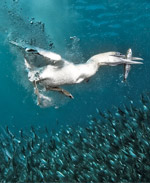
The role of fish in the ecosystem
 1.1 > Interrelationships between organisms can be illustrated as a food web with various trophic levels.
1.1 > Interrelationships between organisms can be illustrated as a food web with various trophic levels.Fish and life in the sea
The ocean is tremendously diverse and species-rich. It is the home of countless organisms living in very different ecosystems. Mussels and worms thriving in the Wadden Sea are a food source for millions of migratory birds. Communities of tube worms, crustaceans and bacteria have developed at volcanic hydrothermal seeps in the deep sea. Elsewhere kelp forests sway with the currents while sea otters on the hunt swim through. Sea birds nest on rugged and rocky coasts while thousands of iridescent fish species frolic in reefs. Fish are a key component of marine biotic communities. For millennia mankind has had an especially close bond with them because they provide people with food. Around 43 million people worldwide make their living directly from fishing or fish breeding. But people are careless with this natural resource. Over thousands of years too many fish have been taken. Many fishing grounds have been overfished. Furthermore, the ocean is being polluted by effluents from industry, settlements and agriculture. Some habitats such as mangrove forests are destroyed directly by construction. Considering the serious situation, it is important to investigate the present status of marine fish.
Fascinating diversity
The diversity is amazing: there are over 30,000 fish species in the world. Some are only a few centimetres long and live hidden among corals. Others, like the blue marlin in the Atlantic, are up to 3 metres long and roam the open sea. Herring glide through the North Sea in large schools, while anglerfish do their hunting in the darkness of the deep sea with a bioluminescent lure extending from their foreheads. Each of these fish types is part of a habitat, an ecosystem, and exists in complex interdependence with many other species in a food web.
- Specialists arrange the organisms within the food web into different nutritional positions called trophic levels. At the bottom there is a myriad of microorganisms. These include microscopic single-celled algae such as diatoms, dinoflagellates and cyanobacteria, collectively known as phytoplankton, which drifts freely in the water. It carries out photosynthesis, which means that it uses sunlight and nutrients to synthesize sugar, and from this builds other energy-rich substances. Scientists refer to this biochemical development of biomass as primary production. Phytoplankton is the food source for small, free-swimming crustaceans or fish larvae, referred to as zooplankton. Zooplankton, in turn, is food for small fish and other organisms. The amount of fish that can exist in a given region is primarily determined by the activity and amount of primary producers; greater primary production can support larger fish stocks. The simple model of a food web in which smaller organisms are eaten by larger ones, however, is not sufficient for explaining the relationships in the ocean. What the larger animals do has an impact on the entire habitat. Many other interactions are also taking place.
- 1.2 > Sardines are also threatened by predators from the air. Cape gannets off South Africa can plunge up to 8 metres below the surface to grab their prey.
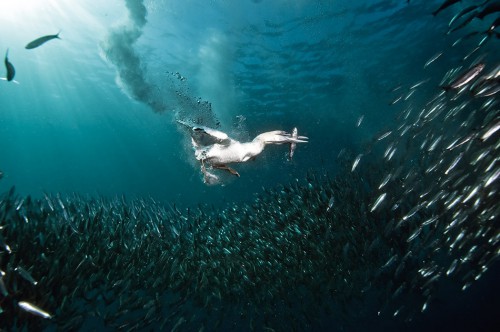
Network thinking
The knowledge that the web of relationships among ma-rine organisms is complex is not new. Similar connections are also known for many habitats on land. But for a long time in the fisheries there was a tendency to focus on individual commercially important species such as cod, herring or sardines. Only in the past ten years has the importance of looking at entire ecosystems become accepted for the long-term preservation of fish stocks and effective management of fisheries. The reason: numerous stocks have been overfished in many ocean regions in the past. In some cases this has resulted in serious changes to the habitats. It is gradually being recognized that the complexity of the marine system has to be considered in fish-ery management. Marine habitats are by no means influenced only by primary production at the base, but also by factors at the higher trophic levels, from the top down.
An example can be seen in the eastern Atlantic waters of the Benguela Current off Angola, Namibia and South Africa. Persistent winds in this region push the surface waters out to sea. This is replaced by nutrient-rich water rising from below near the coast. These upwelling regions are enormously productive and rich in fish. Over many years mostly foreign fleets have fished intensively for sardines here. At the beginning of this century the stock collapsed. Since then the jellyfish population in this region has greatly increased. Experts believe that the decline of sardines represented the loss of an important food competitor because both sardines and jellyfish feed primarily on zooplankton. In addition, young jellyfish are eaten primarily by fish. The jellyfish scourge was unexpected. It was assumed that with the decline of the sardines the abundance of anchovies, another small fish species native to this region, would increase. The anchovy has a diet similar to that of the sardine and should have kept the jellyfish in check. But the anchovy does not appear to be a true competitor of the jellyfish, because so far the anchovy population has remained smaller than that of the sardines. Perhaps the very dynamic upwelling area is a less suitable habitat for anchovies.
- 1.3 > Specimens of the jellyfish Nemopilema nomurai can reach a size of 2 metres and weigh up to 200 kilograms. A few years ago hundreds of these animals drifted into Japanese waters, seriously interfering with fisheries.
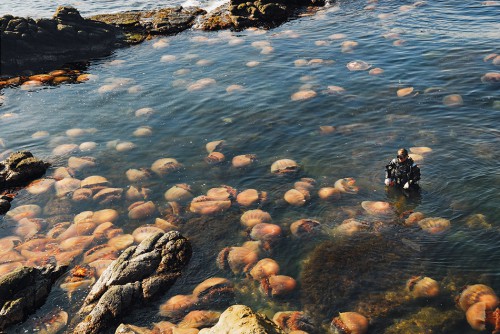
- There is a similar situation off the coast of Japan. The population of the jellyfish Nemopilema nomurai greatly increased there after the intensive fishing of sardines. Individuals of Nemopilema can reach a size of up to two metres. The fishery is now seriously impaired by the jellyfish because they clog up or even tear the nets. But jellyfish do not always proliferate to create this kind of disaster. In the 1970s, off Peru, the large stocks of South American anchovies collapsed. As a result, sardines flourished and a jellyfish plague was avoided. In other words, it is almost impossible to predict today what effects the overfishing of a population will have.
When the big ones land in the net,the small ones benefit
Overfishing has also altered the habitat in the waters off Nova Scotia on the east coast of Canada. For years cod and other bottom-living (demersal) predators such as coalfish have been heavily fished here. The stocks collapsed in the early 1990s. More than 40,000 fishermen lost their jobs. Although a ban on fishing was imposed relatively quickly, the stocks did not rebound even after many years. There is much concern that the habitat has been irreversibly altered.
The cod is a predatory fish at a high trophic level that hunts small planktivorous species, plankton eaters such as the capelin and herring. As the cod disappeared the small planktivorous species became more abundant. Unfortunately, both the planktivorous fish and the larvae of the larger predators feed on zooplankton, which makes them competitors. In addition, the planktivores eat cod roe and larvae, which further increases pressure on the predators. The number of planktivores increased by a factor of nine, while predator stocks remained small.
- The food fish therefore have a strong influence on their predators. Specialists use the term “predator-prey feedback”. Because of this feedback, the stocks of cod, coalfish and other large predators off Nova Scotia have been slow to rebound. The planktivorous fish were thus able to predominate over the predators for a period of 20 years. But now the stocks of planktivores are declining. This is attributed to the fact that the capacity of this region is exhausted: there are so many planktivores that their food supply has become scarce. But a poorly nourished population produces fewer offspring, so the total biomass of the planktivorous fish stocks decreases. The predation pressure on the early life stages of the large predator fish off Nova Scotia has thus declined. As a result the stocks of some predators, for example the coalfish, have recovered. The warning status for cod stocks, however, cannot yet be lifted.
- Similar interdependencies between predator and planktivorous fish are also known from other marine regions. In the Baltic Sea researchers refer to the “cod-sprat swing”. After the general conditions for cod roe and larvae had deteriorated due to low salinity and oxygen deficiency, the cod stocks declined drastically. Because the cod fishery did not adjust to the situation and decrease the catch amounts rapidly enough, the stocks decreased even more. Thus the stocks of their prey, the planktivorous sprat, increased. Because the sprat diet also includes cod roe, pressure on the cod population was further increased. But in this case, temperature also had a crucial impact on the success of the population: slightly increased water temperatures enhanced development of the eggs and larvae of the sprat.
Now the “cod-sprat swing” is sweeping back because the fishery was adjusted: a reduction in cod fishing and interim increase in sprat fishing led to a moderate recovery of the cod stocks.
 1.4 > “Predator-prey feedback”: In the mid-1980s the stocks of the northwest Atlantic cod off Canada drastically declined (left figure). As a result the biomass of the smaller food fish increased (right). In recent years this trend seems to be turning around again.
1.4 > “Predator-prey feedback”: In the mid-1980s the stocks of the northwest Atlantic cod off Canada drastically declined (left figure). As a result the biomass of the smaller food fish increased (right). In recent years this trend seems to be turning around again. There is evidence that not only the planktivorous fish, but also algae benefit from the disappearance of large fish. Planktivorous fish feed on zooplankton, which, in turn, feed on the small free-floating algae, the phytoplankton. Increased numbers of planktivorous fish produce a drop in the amount of zooplankton, and phytoplankton can flourish. This can cause a problem, especially in the nutrient-rich coastal waters where phytoplankton can grow practically unchecked. The result is known as an algal bloom. When the algae die they sink to the bottom. There they are broken down by bacteria, which consume oxygen.
The formation of algal blooms is complex. It seems that a number of favourable conditions must be present at once. In addition to a sufficient supply of nutrients, moderate water temperatures are necessary. By adding the factor of overfishing of large predators, the problem is apparently exacerbated.
There is evidence that not only the planktivorous fish, but also algae benefit from the disappearance of large fish. Planktivorous fish feed on zooplankton, which, in turn, feed on the small free-floating algae, the phytoplankton. Increased numbers of planktivorous fish produce a drop in the amount of zooplankton, and phytoplankton can flourish. This can cause a problem, especially in the nutrient-rich coastal waters where phytoplankton can grow practically unchecked. The result is known as an algal bloom. When the algae die they sink to the bottom. There they are broken down by bacteria, which consume oxygen.
The formation of algal blooms is complex. It seems that a number of favourable conditions must be present at once. In addition to a sufficient supply of nutrients, moderate water temperatures are necessary. By adding the factor of overfishing of large predators, the problem is apparently exacerbated.
- Greater amounts of algae sinking to greater depths results in increased bacterial activity there, and ultimately leads to a shortage of oxygen. Thus, oxygen-deficient dead zones develop in the ocean where neither fish, crustaceans, nor mussels can survive. Many scientists are therefore now urging fishery management to expand their focus from only the species being fished to consideration of the entire habitat. By recognizing the interdependencies among different species and the trophic levels, this ecosystem-based management should prevent the continued damage or drastic alteration of entire ocean regions caused by intensive fishing and consideration or monitoring of single species.
- 1.5 > Copepods are usually only a few hundred micrometres to a few millimetres in size. They are an important food staple for fish and for other crustaceans, and make up the largest share of the marine zooplankton.
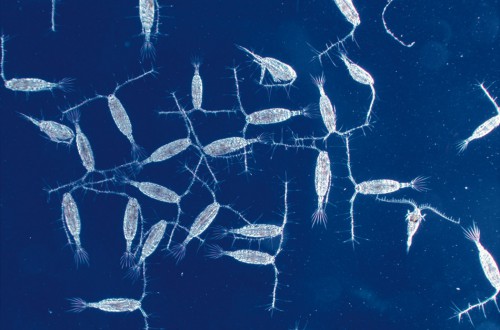
The environment also influences stocks
Fluctuations in the size of fish stocks are not only caused by fisheries. Changes in environmental conditions also affect the stocks. For example, in cold, salty water the Baltic Sea cod produce more offspring than in warmer water with a lower salinity. On the other hand, the animals reach sexual maturity later in colder water. But water temperatures and other environmental parameters fluctuate over time in many marine regions. These are often triggered by natural climate cycles that produce regular changes in winds or ocean currents. One example is the North Atlantic Oscillation (NAO), which influences the climate over parts of Europe and North America. The NAO is a fluctuation of the atmospheric pressure difference over the North Atlantic between the Azores high and the Icelandic low. Among its influences, the NAO affects the winter weather in Europe, and fluctuates with a 10-year rhythm. The wind and near-surface ocean currents in the North Atlantic also fluctuate with the atmospheric pressure.
- In contrast, the El Niño climate phenomenon operates in the Pacific. It alters the current direction in upwelling regions, in this case between the west coast of South America and Indonesia. The large upwelling region off the coast of Chile and Peru is part of a powerful ocean current called the Humboldt Current. This brings cold water from the Antarctic northward along the west coast of South America. Here, like off southwest Africa, nutrient-rich, cold water rises to the surface. The engine for this upwelling is provided by the prevailing trade winds that push the warm surface water from South America westward towards Australia and Indonesia.
South American waters are among the world’s richest in fish. Around 15 to 19 per cent of the world’s catch comes from here, especially small species like sardines and anchovies. The larger horse mackerel, as well as wide-ranging species such as sharks and tuna, are also found here.
But in the years of the El Niño, the westward-blowing trade winds decline and may even reverse direction. This also changes the current direction of the water. Warm, nutrient-poor surface water now flows from the western Pacific towards Peru. These conditions inhibit the production of plankton off the coast of Peru. Food for the planktivorous fish thus becomes scarce, and the stocks collapse. The larger predatory fish and birds, including penguins, are affected, but also mammals such as seals, which rely on the fish as their main food source. In El Niño years they often produce fewer offspring.
- Vital conditions for fish thus change more or less regularly. This can affect both the size of the stocks as well as their geographic extent. The cod population in the eastern Baltic Sea is highly dependent on incursions of salt water from the North Sea. These massive inflows of water occur only every few years under certain weather conditions. They have to be strong enough to override the Darss Sill, a kind of shallows off the coast of Mecklenburg-Western Pomerania. Under normal conditions the heavy salty North Sea water cannot pass over this sill. But during the massive salt-water incursions, enormous amounts of North Sea water flow over the sill and along the bottom of the Baltic Sea as far as Gdansk Bay, and even farther into the Gotland Basin between Latvia and Sweden. This salt-water influx is important because along with the cold saline water it also brings oxygen into the depths where cod spawn. If the salt-water influx does not occur for a long time the spawning conditions deteriorate. Furthermore, it is now known that long-term climate fluctuations impact cod stocks in the eastern Atlantic, the North Sea, and the Baltic Sea. In the 1980s the stocks of gadoids, the cod-like fish, increased greatly in these regions.
The environmental conditions that led to this “gadoid outburst” are still not known. There are a number of hypotheses. It may be that the cold winters of the 1960s and 1970s afforded ideal spawning conditions. In subsequent years the stocks decreased again, presumably not only due to fishing. It is generally true that when a population collapses it is usually associated with a combination of high fishery pressure and changes in environmental conditions.
More data for stock assessment
In order to determine the impact that fisheries have on different ocean regions or to assess the status of a fish species – for example, whether it is overfished or not – many more details are necessary beyond the usual information about the annual catch statistics for a species.
One factor of interest is how the stocks of other fish species in the same region develop, rather than focusing only on the species being fished. Special consideration should be given to the bycatch. This refers to the fish and other marine animals that are unintentionally caught along with the species of commercial interest such as cod or coalfish that are being fished for. As a rule, the bycatch is thrown back.
Because bycatch amounts have not been systematically recorded in the past, an important parameter is missing that would help to assess the population development of several species, as well as the status of the marine region. Fortunately, there are a number of regions today where discarding the bycatch is not allowed. The Euro-pean Union also wants to make throwback illegal. This would make it possible in the future for fisheries to provide valuable data to scientists that would otherwise only be obtainable through expensive research cruises. There is continuing controversy among various specialists, not only about the status of individual species, but also about how the stocks of certain fish species can be best estimated. In any case, obtaining additional data would help a great deal.
In this regard, it would also be important to gather data on the primary producers, the algae and other single-celled organisms, whose quantities and composition substantially contribute to the biomass in the marine region. Such a multiple indicator approach, which considers all of these parameters, could be very important in establishing future catch limits. This kind of comprehensive data set is presently only available for a few fish species, because obtaining the data for all of these parameters is extremely expensive. Furthermore, it requires an intensive exchange of information among scientists of various disciplines, including fishery biologists, oceanographers, and plankton specialists, which has so far only been accomplished for a few stocks such as the Baltic Sea cod and the West Atlantic cod.
- 1.7 > Clupeids frequently form dense shoals, such as here off the Moluccas. They are an important food source for many marine organisms and very important for the ecosystem.
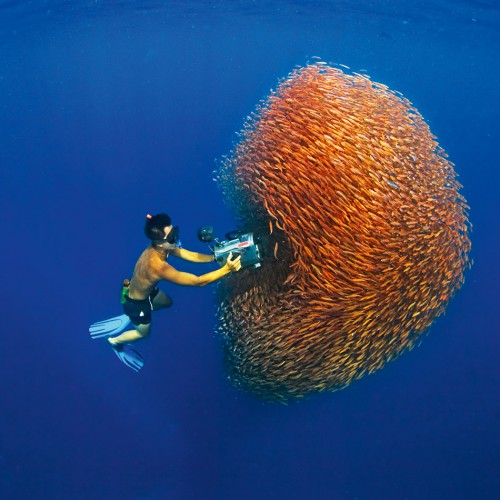
Large Marine Ecosystems
Most marine regions and habitats are so large that they extend across the coastal waters of multiple countries. Comprehensive conservation in these areas is only possible if the countries cooperate, for example, with regard to pollution of the ocean. Even larger fish stocks can only be sustained when the countries agree to joint policies of protective fishery management. For a long time, these kinds of international agreements regarding coastal regions had been lacking. For this reason the National Oceanic and Atmospheric Administration of the USA (NOAA) devel-oped the concept of Large Marine Ecosystems (LMEs) in the 1990s. This divided the coastal marine regions of the Earth into 64 LMEs. Each LME is characterized by a typical flora and fauna. The LMEs extend along the coasts out to the continental slope, where the continental shelf ends and starts its downward incline towards the deep sea. The characterization of certain marine regions by large currents is also considered. For example, the upwelling regions off South America and Southwest Africa are each defined as an LME.
The LMEs comprise all of the coastal regions of the Earth. They are especially productive because they are well provided with nutrients from rivers or upwelling currents. The LMEs produce 95 per cent of the global fish biomass. These areas are also immensely important for humans. Hundreds of millions of people worldwide live near the coasts. Their existence depends more or less directly on fishing. Thus, in addition to the biological factors, the Large Marine Ecosystem concept also deals with socioeconomic aspects.
- 1.9 > The objective of the Large Marine Ecosystem concept is sustainable management of the oceans. Under this approach the status of marine regions is characterized in five different modules.

- With the support of the World Bank and the United Nations Environment Programme (UNEP), an effort is being made to improve international cooperation towards protecting the joint ocean regions, particularly in the developing and newly industrialized countries. Researchers and politicians of the neighbouring countries meet at workshops and conferences. The major challenge is to achieve better protection of the marine environment in spite of differences in interests. Economic aspects such as offshore oil production often have priority over protection of the environment. The concept of the LMEs should provide a counterbalance and create an awareness of the importance of the marine habitat. Political crises and civil wars, however, like that in the Ivory Coast have continued to undermine cooperation in recent years. One focus of the work is to educate qualified people locally. Together with international experts, native scientists are trained to record and competently analyse the stocks of fish, primary producers, and other marine organisms according to current standards. However, in the past many countries have lacked both the funds and sufficient specialists to carry out sustainable fishery management within their territorial waters. Technical knowledge is thus a critical prerequisite for future fishery conservation efforts
- Promising examples are illustrated by the two West African LMEs, the Benguela Current LME and the Guinea Current LME. Numerous courses, workshops and conferences have been held in the countries concerned. One of the present goals is to find indicators for the various LMEs whereby the status of the marine regions can be assessed and described. A sustainable management of the seas should ultimately be achieved. Five working areas, referred to as modules, have been established for this purpose.
- PRODUCTIVITY OF THE HABITAT: Record biodiversity of the phytoplankton and zooplankton and their biomasses, measure the photosynthetic activity, etc.
- POLLUTION AND ECOSYSTEM HEALTH: Investigate the influences of biotoxins, eutrophication of the water, and the development of pathological changes in the marine organisms, etc.
- FISH AND FISHERIES: Investigate the biodiversity and biology of finfish and shellfish, identify fish stocks and changes in their composition.
- SOCIOECONOMY: Investigate the practical application of scientific findings for management of the ecosystems, assess diverse management methods based on economic and other criteria regarding the principle of sustainability.
- GOVERNANCE: Consider ways in which various interest groups in the areas of fisheries, tourism, energy and environment can participate in the development of inter-regional management planning, etc.
- he Large Marine Ecosystems programme has produced a series of studies in which scientists have investigated the development of the LMEs over recent decades. These have clearly illustrated the severe impact that fisheries can have on habitats, but in many cases it is still not clear to what extent natural processes have influenced the devel-opment of fish stocks.
In some years, large oxygen-deficient zones form in the Benguela Current. In these years the stocks of pelagic fish collapse, causing a shortage of food for many species of seabirds and seals. This results in a decline in the survival rates of their young.
Of course the upwelling areas generally exhibit low concentrations of oxygen at greater depths. But it is not yet known why the oxygen-poor areas sometimes extend nearly up to the surface. There is some evidence that the oxygen deficiency occurs after periods of especially intense upwelling currents. This suggests an initial development of large amounts of phytoplankton that later die in large volumes and are subsequently broken down by bacteria. In some cases it appears that a change in current conditions causes expansion of the oxygen-poor areas.
This example illustrates again the importance of understanding the entire ecosystem in assessing the development of populations of marine organisms and ultimately also the fish stocks.
- The concept of the Large Marine Ecosystems is important and necessary. But so far there is little indication that information gained from the international LME projects and activities have led to concrete political directives or national laws. Experts stress the need for action in the future. They agree, however, that LME activities are likely to lead to a greater awareness of marine protection and conservation of fish stocks for the future than has been the case up to now, even in developing and newly industrialized countries.
